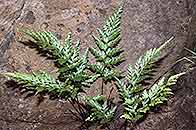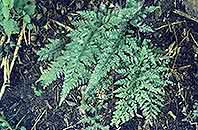Asplenium adiantum-nigrum L. var. adiantum-nigrum
Synonyms |
Tarachia adiantum-nigrum (L.) C.Presl. |
|---|---|
Common name |
|
Description |
Rhizome shortly creeping, ± 4 mm diameter; rhizome scales dark brown, lanceolate in outline, with a latticed appearance, up to 2 mm long. Fronds monomorphic, closely spaced to tufted, thinly coraceous, not proliferous. Stipe 2–23 cm long, shiny black or dark red brown, hairless, the subterranean stipe bases are prominently swollen, semisucculent and pale green. Lamina 2 to 3-pinnate, narrowly deltate to ovate in outline, 4–26 x 2-14 cm; pinnae 7-15 pairs, triangular to broadly ovate in outline, angled forward at 45°, margin evenly dentate with 6-20 small teeth on the ultimate lobes, pinna lobes progressively more dissected towards the base, upper surface hairless, lower surface subglabrous; rhachis black near the base, changing to pale straw coloured towards the apex, hairless. Sori 2-5 per lobe, set along the costae and costules, oval in outline, up to 3 mm long; indusium entire, 0.5-0.7 mm wide. |
Notes | |
Derivation | adiantum-nigrum: black adiantum, vaguely resembling some taxa of the genus Adiantum. |
Habitat | Earth banks in forest, semideciduous scrub, base of boulders in montane grassland, streambanks in montainous areas. |
Distribution worldwide | Africa, Réunion, Iran, Europe, North America, Hawaii. |
Distribution in Africa |
Algeria, Cameroon, Chad, Dem. Republic of Congo, Egypt, Ethiopia, Kenya, Lesotho, Libya, Morocco and Western Sahara, Rwanda, South Africa, Tanzania , Tunesia. |
Growth form |
Lithophytic, terrestrial. |
Literature |
|

